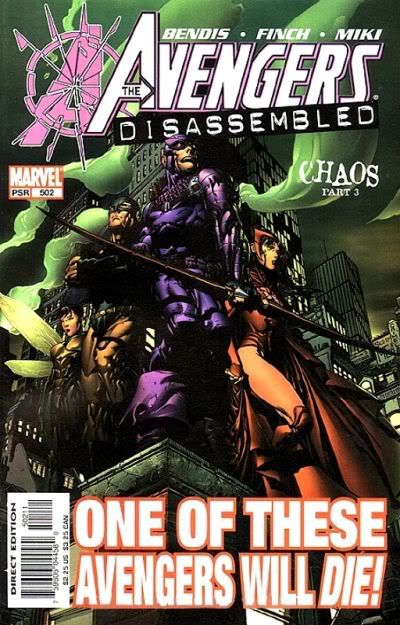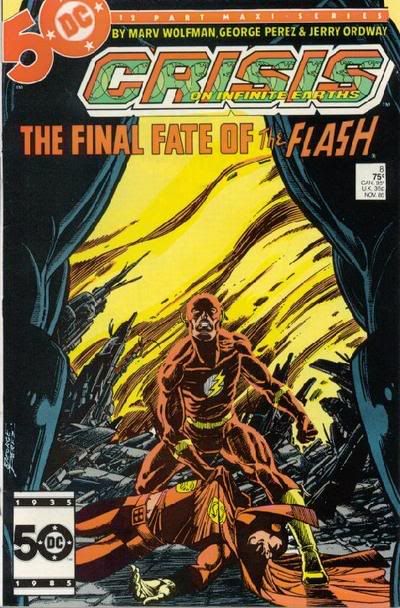The Three Levels of Character Death
So, in light of the events of Captain America #3 and Wolverine #25, I was inspired to attempt a grand approach to the appropriateness of killing off established characters.
I will give away my personal bias right off the bat...I think killing off established characters is one of the lazier things a writer can do. Essentially, what the writer is doing is creating drama without exerting creative effort on his/her part. Instead, he/she is using the work of previous creators to give HIS/HER story drama.
With that being said, I think there are certainly different types of established character deaths in comics, some of which I think are a lot more appropriate.
"But Brian," you may ask, "How can we tell which is more appropriate?"
I'm glad you asked. I have put together a tri-partite system to judge deaths of superhero characters. Appropriately enough, each level is numbered 1, 2 and 3.
3 is the highest level. This is where a story literally revolves around a specific character's death, and therefore, if it were not for this specific character dying, the story could NOT be told. An example of this would be Red Skull's death in Captain America #1. The storyline basically is, "What would happen if Red Skull died in the midst of a evil plan?" So therefore, the storyline could not exist had Red Skull NOT died. Another example is Thor, when Odin died. Dan Jurgens wanted to do a story with Thor becoming the All-Father. This could not occur unless Odin died.
Deaths that are a 3, I judge using a rational basis system. In other words, the death just has to have a rational relation to the story, and I am okay with it.

Level 2 deaths are those that occur in "big" stories, in an attempt to give the story some significance. I would look down upon this type of story a little more if it were not for the fact that the idea of killing off characters to make a story feel more significant is an idea that is fairly ingrained in the American comic book culture. Examples of Level 2 deaths include the Flash in Crisis, Gwen Stacy in Amazing Spider-Man, Northstar in Wolverine, Hawkeye in Avengers and Jean Grey in New X-Men. These deaths are annoying, but I can live with them, so long as they pass the Level 2 test.

The Level 2 test is that the death occured in an "important" story, and the death was substantially related to establishing the importance of the story. If a death fails to meet the Level 2 test, it falls to Level 1, and will be judged by the Level 1 test.
1 is the lowest level. 1 is where basically the "cannon fodder" deaths show up. These are deaths that are sort of "tacked on" to storylines. For example, if we allow that a death is necessary to make a story feel more significant, then OTHER deaths in the storyline will likely be classified as 1's, as they would not, of course, be needed to make the story significant, as the other death achieved that purpose.
Therefore, if the desire is to make Eclipso look like a badass, then it is allowable to kill off an established character. If you kill off SEVEN established characters, though, the extra six are likely to be 1's.
In addition, if the story really was not significant at all, then the deaths are likely to be viewed as 1's. Kevin Smith certainly thought that his Daredevil run was significant, but it sure did not seem so...so the fact that he killed off TWO 30 year old characters in it was fairly ridiculous (and that is not even counting the fact that he was loaned Mysterio by the Spider-Man office under the express provision that Mysterio be given back in the same shape they gave him, as he was being used in a Spider-Man storyline in a couple of months).
The test for Level 1 is that there was a compelling reason for the death in the story, and the death was necessary to achieve that reason. This is a very difficult test to satisfy, so most Level 1 deaths are going to be judged by myself as inappropriate. Two examples of deaths that met the compelling reason test are Supergirl's death in Crisis and Green Goblin's death in Amazing Spider-Man. In Supergirl's instance, they were removing the character from continuity ANYways, so it was safe to kill her off. In Green Goblin's case, he just murdered Gwen Stacy, so his death certainly had a compelling reason.
Now that I have established my tri-partite system, try to apply the test to recent deaths of established characters, and see which level you think they belonged on, and whether their death met the test for that level!
Enjoy!





0 Comments:
Post a Comment
<< Home